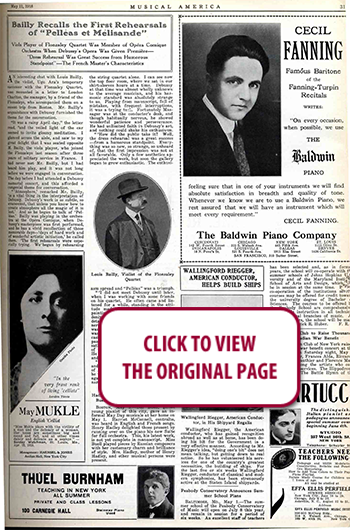 100 YEARS AGO IN MUSICAL AMERICA (241)
100 YEARS AGO IN MUSICAL AMERICA (241)
May 11, 1918
Page 31
Bailly Recalls the First Rehearsals of “Pelléas et Mélisande”
Viola Player of Flonzaley Quartet Was Member of Opéra Comique Orchestra When Debussy’s Opera Was Given Première—”Dress Rehearsal Was Great Success from Humorous Standpoint”—The French Master’s Characteristics
AN interesting chat with Louis Bailly, the violist, Ugo Ara’s temporary successor with the Flonzaley Quartet, was recounted in a letter to Loudon Charlton, the manager, by a friend of the Flonzaleys, who accompanied them on a recent trip from Boston. Mr. Bailly’s acquaintance with Debussy furnished the theme for the conversation.
“It was a rainy April day,” the letter read, “and the veiled light of the car seemed to invite gloomy meditation. I glanced across the aisle, and saw to my great delight that I was seated opposite Bailly, the viola player, who joined the Flonzaleys last season after three years of military service in France. I had never met Mr. Bailly, but I had heard him play, and it was not long before we were engaged in conversation. The day before I had attended a Debussy memorial concert, and this afforded a congenial theme for conversation.
“‘Atmosphere,’ remarked Mr. Bailly, ‘is a vital thing in the interpretation of Debussy. Debussy’s work is so subtle, so evanescent, that unless you know how to create atmosphere all the magic of it is lost.’ And so he began to talk of ‘Pelléas.’ Bailly was playing in the orchestra at the Opéra Comique, when Debussy’s masterpiece was first performed, and he has a vivid recollection of those memorable days—’days of hard work and of wonderful artistic initiation,’ he called them. ‘The first rehearsals were especially trying. We began by rehearsing the string quartet alone. I can see now the top floor room, where we sat in our shirt-sleeves hours at a time. Debussy at that time was almost wholly unknown to the average musician, and his harmonic standard was absolutely strange to us. Playing from manuscript, full of mistakes, with frequent interruptions, it was a trying task. Fortunately Massager was at the conductor’s desk, and though habitually nervous, he showed wonderful patience and perseverance. He had unlimited faith in Debussy’s art, and nothing could shake his enthusiasm.
“‘How did the public take it? Well, the dress rehearsal was a great success—from a humorous standpoint. Everything was so new, so strange, so unheard of, that the first impression was not at all favorable. Only a few aesthetics appreciated the work, but soon the gallery began to grow enthusiastic. The enthusiasm spread and “Pelléas” was a triumph.
“‘I did not meet Debussy until later, when I was working with some friends on his quartet. He often came and listened for a while, standing in the attitude made familiar by the beautiful painting of Jacques Blanche, then suddenly stopping our playing to explain in detail what he wanted. He was very nervous, but he knew well the effects he was after. The realization of his ideal was often so difficult, however, that occasionally he would change the same passage several times before he was satisfied. He had a wonderful knowledge of the possibilities of each instrument. He was a master, a true master, through and through.’
“But the train stopped at Providence, and I had to hurry out. In taking leave of Mr. Bailly I was glad to learn that he would be with the Flonzaley Quartet again next season. He is an extraordinarily fine artist.”




 RENT A PHOTO
RENT A PHOTO





